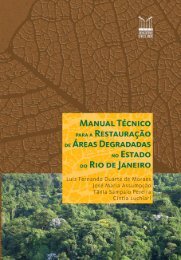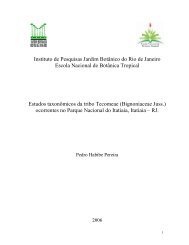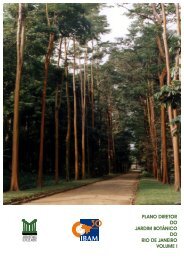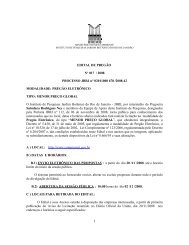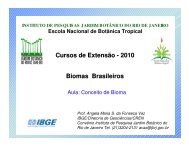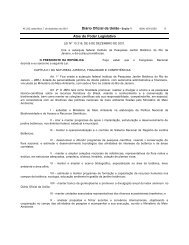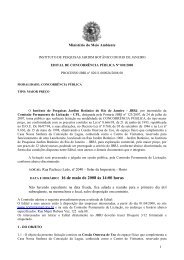anatomia do lenho e dendrocronologia de lianas da famÃlia ...
anatomia do lenho e dendrocronologia de lianas da famÃlia ...
anatomia do lenho e dendrocronologia de lianas da famÃlia ...
You also want an ePaper? Increase the reach of your titles
YUMPU automatically turns print PDFs into web optimized ePapers that Google loves.
46<br />
MATERIALS AND METHODS<br />
There were sampled fifty-seven <strong>lianas</strong> from eight species belonging to Leguminosae family,<br />
subfamilies Mimosoi<strong>de</strong>ae and Papilionoi<strong>de</strong>ae (Table 1). The samples were collected at the<br />
Parque Nacional <strong>do</strong> Itatiaia, municipality of Itatiaia, State of Rio <strong>de</strong> Janeiro, south-eastern<br />
Brazil. Placed between geographical coordinates 22°15’ and 22°30’ S, 44°30’ and 44°45’ W,<br />
within an area of 28,155.97 hectares (http://www.ibama.gov.br). The vegetation type is<br />
Atlantic rain forest (Oliveira-Filho & Fontes, 2000). The Itatiaia range has a pre<strong>do</strong>minant<br />
mountainous relief with several well-<strong>de</strong>limited climatic and vegetation belts related with<br />
altitudinal gradient. The belt where the samples were taken is between 700 m and 1,100 m,<br />
with annual mean precipitation of 1,699 mm, and annual mean temperature 18.2 °C. This<br />
ambient is warm and rainy from December to February and cold and dry from June to August.<br />
From December to February falls 50 % of the annual precipitation and January is the rainiest<br />
month with an average of 289.2 mm. In these months the mean of temperature is 20.8°C.<br />
From June to August falls only 5 % of the annual precipitation and the least rainy month is<br />
June with average 31.5 mm. This cold and dry season has the mean temperature of 15.1 °C,<br />
but was registered absolute minimum of 0 °C. The climate is temperate and humid, and by<br />
Köppen’s system is the Cfb type (Sega<strong>da</strong>s-Vianna & Dau 1965).<br />
There were selected for this study <strong>lianas</strong> with diameter larger than 2.0 cm at approximately<br />
1.3 m above the ground without wounds or <strong>de</strong>formities in this height. The number of samples<br />
per species differed by the difficult to meet individuals with characteristics cited above and<br />
different abun<strong>da</strong>nce of each species. From each sampled individual, a voucher was also<br />
collected, with reproductive and others vegetative parts, which were <strong>de</strong>posited in herbarium<br />
collection of the Jardim Botânico <strong>do</strong> Rio <strong>de</strong> Janeiro (RB).<br />
Wood samples of stems were collected at approximately 1.3 m above the ground. There were<br />
taken partial or complete cross-sections with approximately 2 cm length, including bark,<br />
wood and some times the medulla. Blocks were polished for macroscopic observation with<br />
hand lens and stereomicroscope Olympus SZ11. The images were taken with photographic<br />
camera Olympus C5050 attached to the same stereomicroscope.<br />
For light microscopy, boiling water and glycerine were used to soft part of the blocks.<br />
Sections with 16 to 30 µm thick were ma<strong>de</strong> in transversal, tangential and radial plains with<br />
Spencer 860 sliding microtome. After that they were cleaned, stained with safranin and astra<br />
blue (Bukatsch, 1972), <strong>de</strong>hydrated and mounted on Permount resin in permanent sli<strong>de</strong>s.<br />
Sli<strong>de</strong>s were observed at Olympus microscope BX50 and images captured with system Image


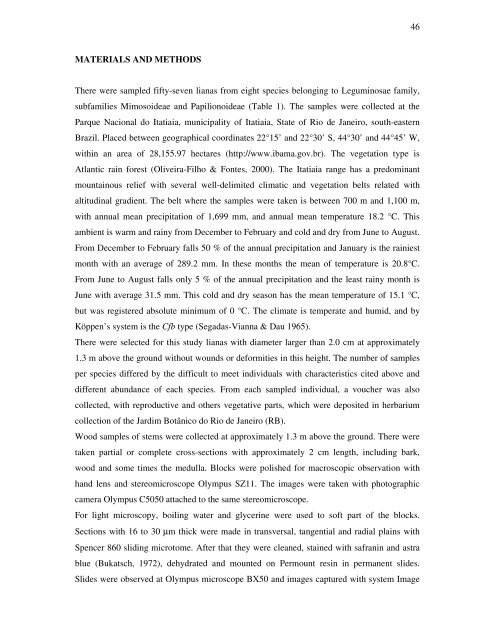
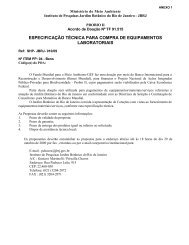
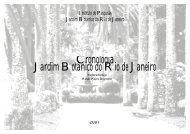
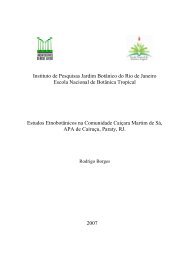
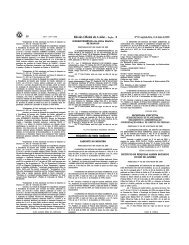
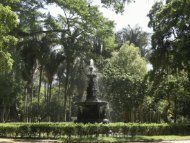
![Memorando nº [Número do memorando/DAMF-RJ/Nome da Unidade]](https://img.yumpu.com/43163661/1/184x260/memorando-na-namero-do-memorando-damf-rj-nome-da-unidade.jpg?quality=85)
